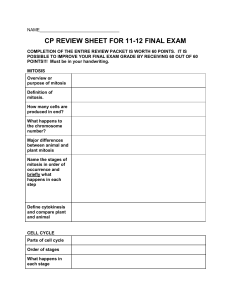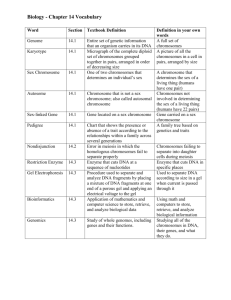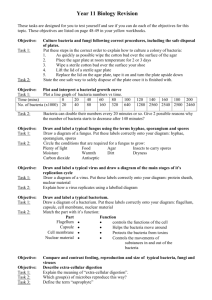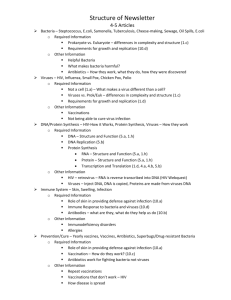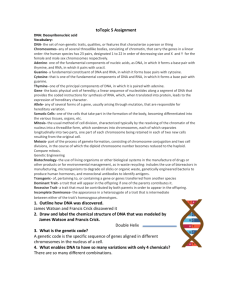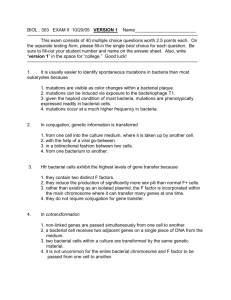NAME_________________________________ CP REVIEW
advertisement
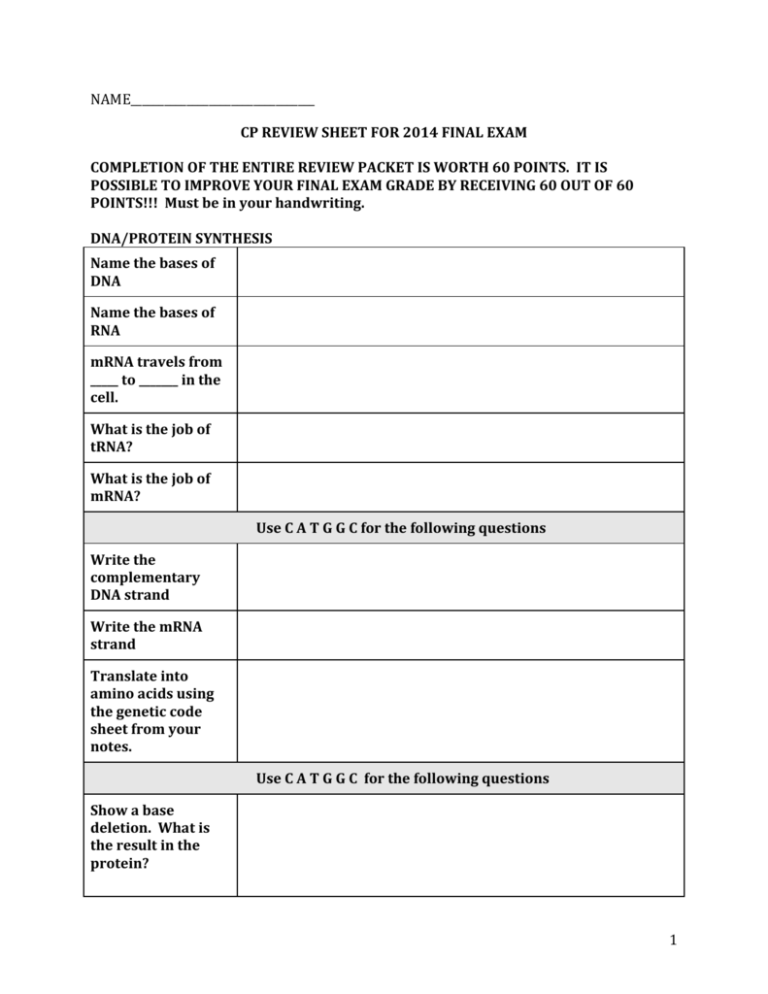
NAME_________________________________ CP REVIEW SHEET FOR 2014 FINAL EXAM COMPLETION OF THE ENTIRE REVIEW PACKET IS WORTH 60 POINTS. IT IS POSSIBLE TO IMPROVE YOUR FINAL EXAM GRADE BY RECEIVING 60 OUT OF 60 POINTS!!! Must be in your handwriting. DNA/PROTEIN SYNTHESIS Name the bases of DNA Name the bases of RNA mRNA travels from _____ to _______ in the cell. What is the job of tRNA? What is the job of mRNA? Use C A T G G C for the following questions Write the complementary DNA strand Write the mRNA strand Translate into amino acids using the genetic code sheet from your notes. Use C A T G G C for the following questions Show a base deletion. What is the result in the protein? 1 Do a single base substitution. What are the possible outcomes in the protein? Who are Watson and Crick? Define transcription. Define translation. Define DNA replication and know basic steps using the two main enzymes (DNA polymerase and DNA helicase). Define a mutation. Are all mutations bad? Explain. MEIOSIS What is the purpose of meiosis? What does meiosis produce? diploid (notation and definition) haploid (notation and definition) chromosome number in sex cell chromosome number in body cell 2 chromosome number in zygote Define gametes What does fertilization do to the chromosome number? What is nondisjunction? What is a translocation? What is a chromosome insertion? Name the cause of Down’s syndrome What are the # of chromosomes in Down’s Which chromosome is involved with Down’s Describe Turner Syndrome and the problem with chromosomes. Describe Klinefelters and the problem with chromosomes. Know what a karyotype is and how to read one. 3 What is crossing over? How does it help with genetic variation? GENETICS Who is Gregor Mendel and for what is he most known? Organism Mendel used Define a dominant trait. Define a recessive trait. What is a homozygous genotype and give example? What is heterozygous genotype and give example? What is an allele? Complete the following crosses: TT x TT, punnett & results tt x tt 4 Tt x Tt Tt x TT Tt x tt Define F1 & F2 generations. What is a test cross and why would you do one? Give an example. What is a genotype? Give an example. What is the relationship between alleles and homologous chromosomes? What is a phenotype? Give an example. 5 Cross BbRr x BbRr Show Punnett, and Phenotype Ratio results Genetics 2 What is incomplete dominance and codominance? Know the difference and show an example. If you cross incomplete dominant red flowers with white flowers, what do you get? What are sex linked traits and give 2 examples from notes? Which gender inherits sex linked trait more? Why? How does a child inherit a disease if the parents do not have it? 6 Which type is the universal blood donor? Which type is the universal blood recipient? Cross IAIBx ii (AB xO) Cross ii X ii (O x O) Cross IBi X IAi (BO x AO) What is Sickle cell anemia and how is it inherited. Be able to construct and read a pedigree to predict inheritance patterns. 7 Try writing the symbols and making a small pedigree here. EVOLUTION Describe the Theory of Natural Selection. Who is responsible for publishing about natural selection? Describe Lamarck’s theories about evolution. Why did Darwin’s theory replace Lamarks’ theories? Describe the giraffe necks according to Lamarck. Describe the giraffes according to Darwin. Define “vestigial” and give 1 example. Define “homologous structure” and give 1 example. 8 Define “analogous structure” and give 1 example. Explain and recognize the 5 major types of evidence that supports evolution. Describe how natural selection occurs. Give 1 example. Describe artificial selection and give 1 example. Compare and contrast convergent and divergent evolution and examples of each. ECOLOGY What is an ecosystem? Define food chain. Describe the following community interactions, with examples: Mutualism Commensalism 9 Parasitism Predator /Prey Competition Define Competitive exclusion (consequences of competition) and give an example. Energy pyramid (10% rule) Predator What do Herbivores eat? What do Carnivores eat? What do Omnivores eat? Define habitat. What is a community? What is a niche? What is ecology? What is the importance of decomposers and name 3 examples? 10 What are pioneer organisms in ecological succession and name 2. Draw a generic food chain with labels showing 4 trophic levels What is the Greenhouse effect and why is it significant? Gases of global warming Cycles like water cycle, nitrogen cycle, carbon cycle Describe the population growth patterns, exponential and logistic. Be able to draw and interpret each graph type. Limiting Factors: Density dependent and Independent 11 What is carrying capacity? Explain eutrophication, biodiversity, and ozone depletion. VIRUSES How viruses reproduce? What are RNA viruses are called that do reverse transcription? Describe the lytic cycle. Describe the lysogenic cycle. Draw and label 2 parts of a basic bacteriophage virus. What is the cure for a virus? How could you prevent a viral infection? What prescription works on bacteria, but not viruses? Name an infamous retrovirus. 12 What is a provirus (prophage)? BACTERIA 3 basic shapes of bacteria, draw and label Define prokaryote and give examples. What are the two domains that prokaryotes fall into and what are the basic characteristics of each. Why is it dangerous to use antibiotics incorrectly? What is the function of the capsule in bacteria? What is the function of the pilli function on bacteria? What is a Petri dish used for? Give an example of at least three pathogenic bacterium. Name three ways bacteria are important to life and humans. 13 Name and describe TWO was that bacteria increase their genetic variation. SHORT ANSWER TOPICS YOU WILL CHOOSE 5 OUT OF THE FOLLOWING 7 TOPICS AND DO PRE-WRITING. NOT OPTIONAL. THIS PART COUNTS AS 10 POINTS OF YOUR REVIEW PACKET. 1. Cross involving colorblindness which is a sex-linked trait found on the X chromosome. (punnett squares, %, etc.) 2. Be able to transcribe and translate a DNA sequence into amino acids and relate that to mutations. 3. Know how and why pedigrees are used and be able to predict genotypes and phenotypes of traits using a pedigree. 4. Bacteria- reproduction and ways bacteria can increase their genetic variation, helpfulness, how they harm 5. Adaptation and survival- natural selection how it occurs, fitness, variation. Be able to relate adaptations to their environment and make predictions. 6. Food web and how it works, be able to explain the significance of the different trophic levels and how the energy moves through the food web. 7. Community interactions and relationships- predation, mutualism, parasitism, commensalism, competition be able to define, compare and contrast and give examples. 8. Antibiotic resistance. Explain how antibiotic resistance is becoming a problem. You must incorporate the idea of natural selection and explain this fully. 14
